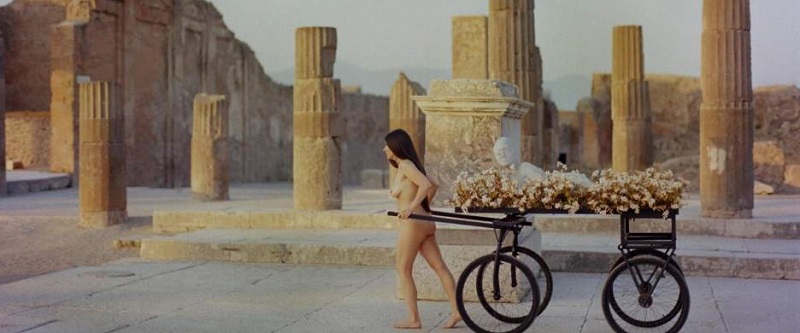What is the distance between a Swede sculptural beauty soaking in the Fontana di Trevi and an Italian brunette eating spaghetti, in a histrionic style, before the Fontaine Saint Michel in Paris? The latter, in a cannibal act, “devours” the misogynous construction that the first epitomize. It was one of the urban performances that the Neapolitan artist Romina de Novellis made when settling in the French capital (Splash! La Dolce Vita a Parigi 2010).

Continuing with film references we can say that Romina, at that time, had already been seen wandering around the city under the influence, or if you prefer, on the verge of a nervous breakdown (Il Capitano, Paris 2009). Perhaps, the practice of eccentric behaviors allowed the artist to free herself from expectations about the role of women rooted in her home country, and when she rearranged herself in a new scenario came to the surface the tragicomic element of that lonely soul-searching.
In later actions, she will continue exploring creative alienation as a driving force to interrupt inertia, to transgress everyday rituals. Many times, she achieves it exploring the compulsive repetition of a gesture that introduces the spectator into a symbolic level.
So, for hours, even spending a whole night carding wool, washing clothes, weaving or unraveling.. you seem to merge the image of a traditional woman with mythical figures as Arachne, Penelope, Ariadna… (in La Veglia, La Pecora…)
In my work, the repetition of a gesture leads to self-analysis; is a way to understand how we are trapped in different kinds of social cages that we often build around ourselves. We think we can protect ourselves, but what I am trying is to raise awareness of the fact we are the cause of our condition, of our difficulties and sufferings. Repetition is synonymous of boredom, routine, pre-established and repetitive patterns, which do not allow the human being to express himself and go to the bottom of things. In this situation, we are forced to constantly project ourselves beyond our own cages, in a utopian sense, and now even in a virtual way.
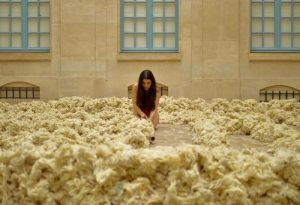
I lead the traditional woman out of her own myth, annihilating the macho stereotypical assumption about women who can wait, who know how to weave, how to fulfill her duties… I translate such visions into a contemporary context. The problem is not the role of women, which fortunately today is changing, albeit very slowly. The problem is the misogynistic projection of women in society: this aspect in the consideration of the female gender still has a long way to go.
In La Gabbia the repetitive gesture was to erect a wall of roses around you, in a similar way to the veil of red threads in La Veglia, but on the first, you were naked inside a cage. This was a tragic gesture because involved a certain annulment of the self.

La Gabbia (The cage) is a work on the right to put an end to one’s suffering, first of all as a body. I think of the diseases that put the human body in a mortifying condition, I think of old age, I think of all the people who want to stop their pain. La Gabbia is a poetic work that expresses the beauty of the individual, free to do what he wants with his body.
An important issue for you is the family, with its restrictive but also protective burden. In “Sacra Famiglia», you and your friends formed a mystical and surreal procession getting around the old town of Naples on Christmas Eve. Ending up in the sea to be reborn?

Finish at sea, first of all to finish! To end up with the hypocrisies of Mediterranean cultures (and others) still centered on this very ancient social burden about the concept of family. To end with hypocrisies that want to transmit and teach the family values, family duties, family rights, etc. at all costs.
Finish at sea as a certain death of the current society in which we live, which is slowly imploding. To end up in the sea as a rebirth, a probable rebirth, if only I had the certainty that there is the possibility of reincarnation of individuals but not of social patterns and institutional models that society has always imposed on us. Finish at sea to drown ourselves, to concretely and drastically end the hypocrisies that we create.
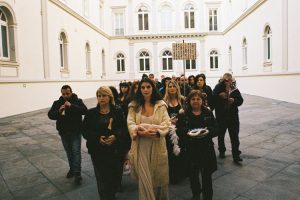
On another occasion, you and your family lived with vultures for a few days, and then you did a performance (Augurii 2014) inspired by Leonardo’s painting «Saint Anne, the Virgin and Child» in which Freud saw the hidden figure of a vulture. He interpreted it as a goddess mother associated with Mut. Do vultures also symbolize motherly vigor for you?
No, the vultures symbolized for me the natural cycle: the body that becomes carcass is then devoured and made disappear by the vultures. After the birth experience, my body had emptied. I wanted to work symbolically on this passage to another body, with another sense, ruin of what I was until before the birth of my daughter.
If reincarnation exists, it is probably in the body’s ability to be reborn after having emptied itself of life.
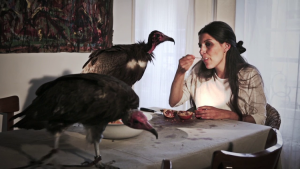
In «Gradiva» (2017) you pushed a cart through the ruins of Pompeii. The title evokes that female specter (from Wilhelm Jensen’s novel) generated by an archeologist and his fear of living. He buried his memories under the lava. But for you, what represents Gradiva?
My Gradiva is the ghost of a society that is dragging, that believes that it can continue to do so. It is a metaphor of the current social situation, especially in the Mediterranean that denotes its fatigue and Europe that leave it to its own devices but for a tsunami or boomerang effect returns delivering the same battles.
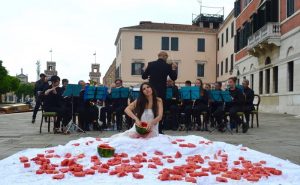
My Gradiva is the utopian ghost of a society that believes that it can continue to exist, without realizing that it is nothing more than a pile of ruins, that it is limited to dragging its own corpse.
Another performance charged with literary references was «Inferno». Presented at Palais de Tokyo (2015), the gala guests ate watermelon, so by applying the «law of the contrapasso» (the same that Dante inflicts on the damned) you devoured watermelons while your dress was soaking wet by juice. This same action had other connotations when you performed it in Venice: from gluttony associated with collecting to blame in relation to Sea, migration, blood… Is it like that?
Yes, it is exactly like that, it is for what is called Hell: because we are all already in Hell and we are already all victims of our own actions. We live in an age of fake values, moralisms and virtual projections of utopian lives: we are already in Hell, we are self-plotting, self-flogging, self-humiliating, we are perpetrators and victims of our own way of living and acting.
Interviewed by Anna Adell
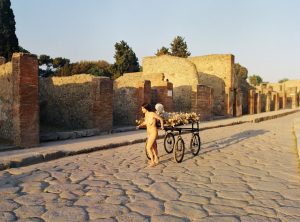
Upcoming events:
– La Veglia, Villa Datris Foundation, May 2018 (live performance+ group show)
– Arachne: a live performance in collaboration with Ramdom and Lastation, Gagliano del Capo, June 2018
– Manifesta 2018, Palermo
– Vertiges, group show, Labanque, Béthune, curated by Léa Bismuth
– Group show, Alberta Pane Gallery, Venice, October 2018
…

